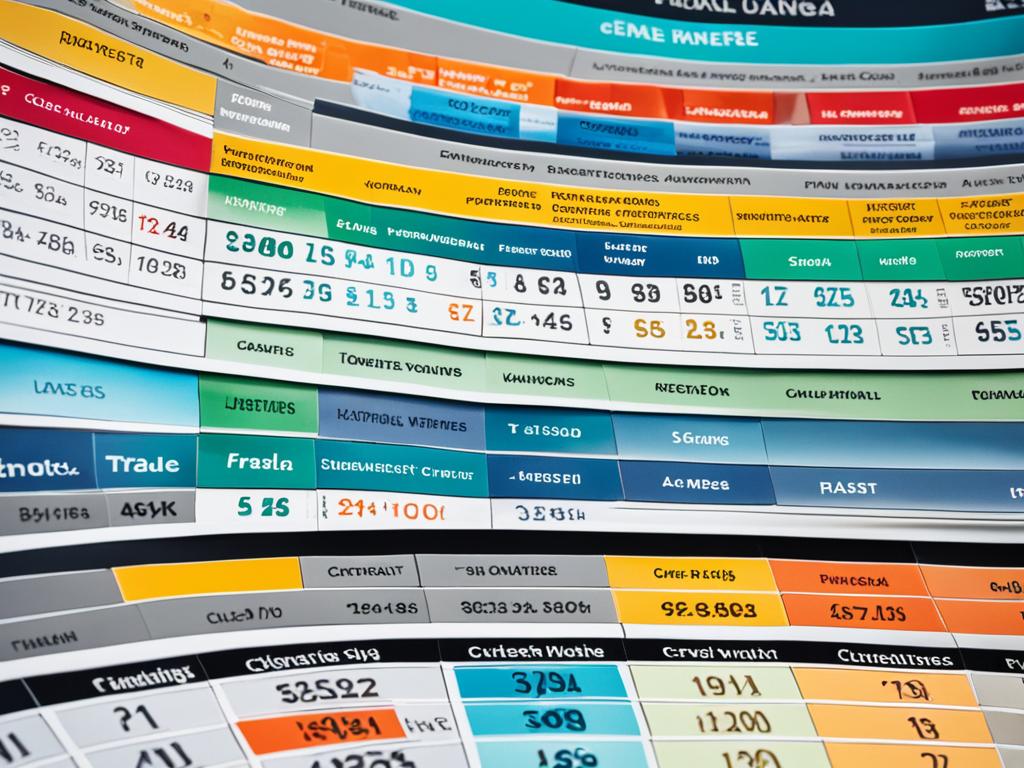
Understanding the Different Types of Financial Markets
The world of finance is complex, filled with various financial markets. These markets range from the busy stock exchanges to the fast-paced over-the-counter (OTC) markets. Each one is vital to the global financial system. This article will look into the different financial markets, their roles, and the assets traded in them.
Financial markets are where people buy and sell financial items like stocks, bonds, and currencies. They are key to the global economy, helping move money, manage risks, and put resources where they’re needed. It’s important for investors, policymakers, and finance enthusiasts to understand these markets well.

These markets can be split into two main groups: primary and secondary markets. Primary markets are where new securities first sell to the public. Secondary markets trade existing securities among investors. Markets also vary by the assets they deal with, such as stocks, bonds, and derivatives.
Knowing how these markets work means understanding the people involved. This includes individual and institutional investors, brokers, dealers, and regulators. Each group has its own goals and influences the market’s behavior and trends.
The financial world is always changing, so staying updated is key. By learning about the different financial markets, investors and professionals can make better choices. This knowledge helps them take advantage of the many opportunities these markets offer.
What are Financial Markets?
These markets are where people and companies buy and sell things like stocks and bonds. They are key for moving money around, finding fair prices, and helping businesses get funds. They also help investors manage their money.
Role of Financial Markets
These markets do a lot for the economy:
- They let people and groups trade things like stocks and bonds in a safe place.
- They help move money from those who save it to those who need it for investments.
- They figure out the right price for financial assets by looking at supply and demand.
- They make it easy to buy and sell assets quickly and at good prices.
- They help investors manage risks with tools like derivatives.
Key Participants in Financial Markets
Who are the main players in financial markets?
- Individual Investors: People who put their own money into financial assets for goals like retirement or growing their wealth.
- Institutional Investors: Big groups like mutual funds and pension funds that handle a lot of money for their clients.
- Banks: These are places that lend money, take deposits, and offer investment services.
- Brokerages: These are companies that help buy and sell financial assets for their clients, making money from commissions.
- Regulatory Authorities: These are government groups and organizations that make sure financial markets are fair, open, and stable.
These groups work together to make financial markets run well. This is important for the economy’s growth and stability.

Primary Financial Markets
These markets are key in the finance world. They are where new financial tools like stocks and bonds first appear. These markets help companies and governments get money by selling their securities to investors.
The primary market is where the initial public offering (IPO) of stocks happens. This lets companies grow and expand. It also lets investors own a part of these businesses.
Primary markets also issue new debt tools like government bonds and corporate bonds. These help governments and companies get money for things like building projects, growing their businesses, or paying off debts.
The primary markets are crucial for financial markets, investment banking, and portfolio management. They let investors buy a variety of financial assets. This helps them create diverse investment portfolios.

In short, primary markets are the base of the financial system. They give companies and governments the money they need to succeed. At the same time, they give investors a chance to be part of these opportunities.
Secondary Financial Markets
The financial markets are huge and complex, with primary markets for new financial tools and secondary markets for trading old ones. Stock exchanges and over-the-counter (OTC) markets are key players in these secondary markets. They help move money around the world.
Stock Exchanges
Stock exchanges like the New York Stock Exchange (NYSE) and Nasdaq are places where shares of companies are traded. They help set prices, make trading smooth, and move money around. This makes them vital for the financial world.
Investors use stock trading strategies to make the most of market trends. This helps them make money in the equity markets.
Over-the-Counter (OTC) Markets
OTC markets are different from stock exchanges. They don’t have a central place and are spread out. These markets are important for trading things like derivatives and bonds.
They offer flexibility and access to a wide range of investments. This is good for investors, financial institutions, and others looking for specific deals.
Stock exchanges and OTC markets are key parts of the financial markets. They meet the investment needs of many people and businesses. Knowing how they work is important for those in investment banking, trading, and following market trends.

Financial Markets by Asset Class
These markets are divided into different asset classes. These include the equity markets, bond markets, and derivative markets. Each plays a unique role for investors and financial institutions.
Equity Markets
Equity markets let people trade shares in companies. Investors buy and sell these shares to make money from rising stock prices. This is a key way for investors to get into the growth of various businesses.
Bond Markets
Bond markets are for trading fixed-income securities like government and corporate bonds. These bonds offer regular interest payments and the chance for the value to go up. They are vital for governments and companies to get money for their needs.
Derivative Markets
Derivative markets deal with financial tools like options, futures, and swaps. These tools get their value from things like stocks, bonds, or commodities. Investors use them to manage risks, bet on market trends, and use complex strategies. Derivatives make the financial markets more complex and liquid.
Knowing about the different asset classes and markets is key for managing a portfolio, analyzing risks, and understanding financial markets.

Global Financial Markets
The global financial markets are a complex network, with key financial centers around the world. These markets are shaped by many things like economic policies, global events, and new tech. From New York to London to Tokyo, they’re all connected.
It’s vital for investors, businesses, and policymakers to grasp the global financial markets. These markets are crucial for the global economy. They help move money, trade securities, and manage risks.
At the core of these markets are the financial markets. They’re divided into three main types: equity markets, bond markets, and derivative markets. Each type serves different needs of investors and businesses.
The equity markets let investors buy and sell company shares. They aim to make money from share price increases and dividends. The bond markets help governments and companies borrow money. The derivative markets help investors manage risks like price changes or interest rate shifts.
The role of the these markets in the global economy is growing. As the economy changes, so does the need for investment banking and equity research. Staying updated on market trends helps businesses and investors succeed in this complex world.
In short, the global financial markets are key to the global economy. They help move money, trade securities, and manage risks. Knowing how these markets work and who’s involved is crucial for investors, businesses, and policymakers.
Financial Markets and Investment Banking
Investment banks are key players in the financial markets. They help shape the investment world. They offer many services, like underwriting and managing mergers and acquisitions, and they have detailed portfolio management strategies.
Investment Banking Services
Investment banks connect borrowers with lenders and help move money around the financial markets. They provide important services such as:
- Underwriting – They help companies raise money by selling securities to the public or big investors.
- Mergers and Acquisitions – They advise on big deals like merging companies or selling parts of a company.
- Equity and Debt Financing – They set up financing plans for clients, including equity and debt options.

Portfolio Management Strategies
Investment banks also offer portfolio management help. They work with investors to build and manage their portfolios. They consider the investor’s risk level, goals, and market trends. With their deep market knowledge, they help investors create strong trading strategies for the financial markets.
Knowing how financial markets and investment banking work together helps investors make better choices. It lets them adjust their portfolio management and trading strategies to fit the market.
Risk Analysis and Trading Strategies
Understanding these markets is complex and ever-changing. Investors and traders use many techniques to spot trends, assess risks, and make smart trading moves. These methods include fundamental and technical analysis, and risk management. They help in making decisions based on goals and how much risk one can take.
Fundamental analysis looks at the big picture, like the economy, industry trends, and a company’s finances. Technical analysis digs into past price and volume data to find patterns. Risk management, through diversification and hedging, helps protect investments from big losses.
Good trading plans often mix these methods. This way, investors can make better choices and manage their money well. Knowing about risk analysis and trading strategies helps investors move through the markets with confidence. It can also help them reach their investment goals.
FAQ
What are financial markets?
These markets are places where people buy and sell things like stocks and bonds. They help move money around, find prices, and let companies raise money. They also let investors manage their money.
Who are the key participants in financial markets?
Important people in these markets include individual and institutional investors, banks, brokerages, and regulators. Each group is key to making these markets work well.
What is the difference between primary and secondary financial markets?
Primary markets are where new things like stocks and bonds are first sold. They help companies and governments get money from investors. Secondary markets are where these things are traded again, with big exchanges and OTC markets being the main places.
What are the main asset classes traded in financial markets?
The main things traded in these markets are stocks, bonds, and derivatives like options and futures.
How are global financial markets interconnected?
Global financial markets are linked, with big centers like New York, London, and Tokyo playing big roles. They’re affected by things like economic policies, world events, and new tech.
What is the relationship between financial markets and investment banking?
Investment banks are key in financial markets. They help with things like underwriting and financing. They also help investors with their portfolios, based on what they want and the market.
What are the key risk analysis and trading strategies used in financial markets?
Investors and traders use methods like fundamental and technical analysis to spot trends and manage risks. They can choose from different strategies, from long-term investing to short-term trading, based on their goals and how much risk they can take.



This post has given me a better understanding of the role of stock exchanges. Thanks for the insight!